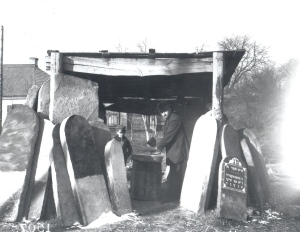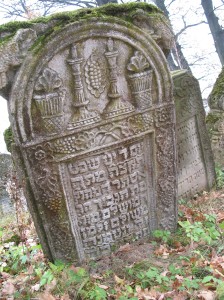By Ruth Ellen Gruber
A few days ago, I posted this picture of a tombstone-carver, taken in Ukraine in 1916.
The one finished tombstone that you can see is very simply carved, but clearly painted in at least three colors. It also appears that the stone-carver may be teaching his son the trade — several sources, including David Goberman and the art historian Moshe Barasch report that tombstone-carving was often (or at least sometimes) a family business, passed on down the generations. In his essay “Reflection on Tombstones: Childhood Memories” (which I have cited before for Barasch’s contemptuous attitude toward the “primitive” artistic character of the stones) Barasch recalls hearing about two families of tombstone-carvers in Czernowitz after World War I — the Picker family and the Steinmetz family (the name means “stone carver”), both of which had been in the business “for several generations.”
In his PhD dissertation on Jewish tombstone inscriptions and iconography is what is now western Ukraine, Boris Khaimovich of the Center for Jewish Art in Jerusalem cites an interview conducted in 1926 with the last professional tombstone carver from the town of Ozarintsy in Southern Podolia. (For a fascinating account, including photos, of growing up in Ozarintsy at that time, click HERE. a photo of a synagogue in Ozarintsy in 1928 click HERE.) He was a young man named Goldenberg. Taranoshchenko wanted to find out “what guided him in carving certain images on a tombstone: whether definite rules and tradition, or the wishes of the dead person’s family, or perhaps his own imagination.”
The young carver apparently had “poor knowledge of ancient tradition.” But he did adhere to memories of this and said he was “usually guided” by certain considerations. Regarding women’s tombs they were:
1) for the grave of a young girl – a chopped down tree, a small fir-tree, a wreath, a bird;
2) for the gravestone of an important woman – a candelabrum (since the mistress of the house must light Shabbat candles), two candelabra, two birds
(Sergey Kravstov of the Center for Jewish Art in Jerusalem has informed me that the interview was conducted by a Ukrainian scholar named Danylo Shcherbakivs’ki [1877-1927], who had a tragic history under the Soviet regim. In a lecture that will soon be published, Sergey explains: “Research of Jewish monuments went on in the Soviet Ukraine. Ukrainian art historians and ethnographers included it in the curricula of the1920s. Great efforts were undertaken by Danylo Shcherbakivs’ky, the museum curator and a professor at the Academy of Arts in Kiev, who organized student expeditions to Podolia and Volhynia. Shcherbakivs’ky tended to construct the art history of Ukraine along the lines of that of other European state nations, and thus his attitude to Jewish monuments was inclusive. Impeded in his many initiatives by the Commissars, he committed suicide in 1927; his name was blotted out of the Soviet curricula. Other great Ukrainian figures were a museum curator Stefan Taranushenko, and his assistant Pavlo Zholtovs’ky. By 1930, their documentation of Podolian synagogues in Mińkowce, Michałpol, Smotrycz, and Jaryszów had expanded knowledge about the wooden synagogues, surveyed in previous decades. However, the stifling atmosphere of the Soviet Ukraine barred any possibility of a comprehensive study of these monuments. Both researchers were arrested in 1933. Taranushenko was able to return to Ukraine only in 1953. Zholtovs’ky returned to Ukraine in 1946, and then he had the courage to study Jewish art in Lviv.”)
The earliest tombstones bearing candlesticks to mark women’s tombs that were found and described by Boris Khaimovich in Ukraine and Silviu Sanie in Romania (Siret, just on the Ukrainian border) date from the late 18th and very early 19th centuries. By the mid-to-late 19th century, the imagery was almost universal.
The young carver Goldenberg’s account in Ozarintsy shows how strongly engrained the tradition became.
Boris Khaimovich concludes that:
Apparently, the “poor knowledge of tradition” referred to the fact that the carver neither used nor knew the meaning of the motifs depicted on old tombstones, which the researcher had also documented in the murals of the Ozarintsy synagogue. This means that the tradition was totally lost by the turn of the 20th century. At the same time, the carver’s testimony sheds some light on the nature of this phenomenon, and clearly point at the existence of a special symbolic language, of which Goldenberg’s generation retained no more than vague notions and echoes. (BK Dissertation, p. 158)


